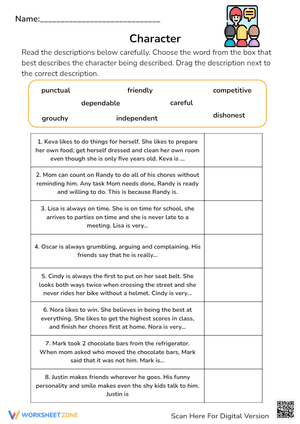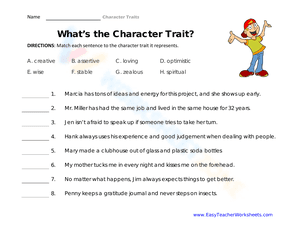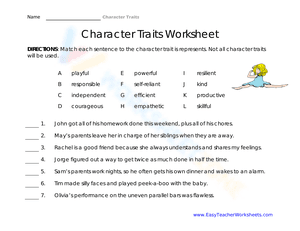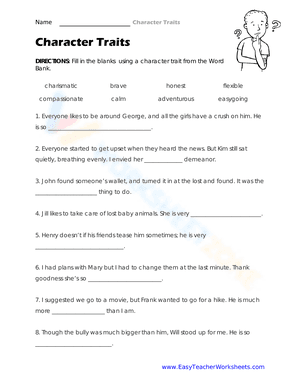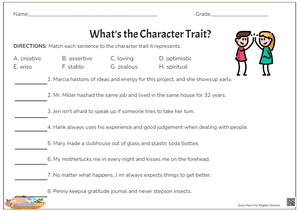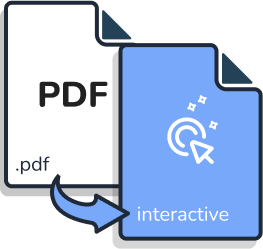Character traits are the features or characteristics that distinguish an individual or a fictional character. For example, Harry Potter is courageous, Katniss Everdeen is resourceful, and Mario is daring. Sometimes the characteristics are clear, such as Harry's bravery when battling Voldemort. Sometimes they can be more subtle, such as Katniss' resourcefulness when she discovers how to live in the Hunger Games.
Consider creating a new character for a narrative you're writing, or analyzing a protagonist from a book that you're reading for class. You'd want to consider what that character is like - their personality, how they react to problems, what they like or dislike, and so on. This is when character traits worksheets come into play.
WorksheetZone Character Traits Worksheets
Character trait worksheets are intended to help you consider, analyze, and describe characters. They frequently contain many sections that guide you through describing a character's attributes. For instance, there could be a part where you list the character's physical characteristics, such as hair color, age, and height. Then there may be a section where you describe the character's personality attributes, such as whether they are timid or extroverted, nice or mean.
It is really beneficial to require students to read well-known literary masterpieces created by skilled writers. It's quite another to use literary classics as an engaging teaching tool that encourages your children to request more reading time. All character traits worksheets on our website emphasize a good character quality you want your children to grow into. Students are encouraged by the courses to connect their own characteristics to the struggles the main fictional characters confront in real life. These exercises will assist students with character analysis across a wide range of genres. Teachers and parents can make their own
A person's views and value system are fundamentally based on their character traits. These characteristics can be identified in fictional characters based on their deeds, statements, and thoughts. In essence, it serves as a gauge for the person. Do they normally have a cheerful attitude or do they always seem to be in a bad mood? They may exhibit exceptionally admirable qualities like generosity, patience, or extreme fairness. On the flip side, they may exhibit undesirable qualities like being nasty, unkind, or dishonest. Over the course of a story, these characteristics can change. When a character is first introduced, we receive a sense or basic concept of what they might do in various circumstances, and we can then base our predictions on this. The character traits worksheets that follow will assist students in evaluating the personalities of fictional characters in literary works. If you are a teacher or parent and you want to create worksheets that focus on your students' favorite characters, you can use our free worksheet maker to make one. Learning will become more effective when they meet their loved ones there.
How to Spot Character Traits in a Story?
Actions – Pay close attention to what the characters do during the story. Their acts disclose a great deal about their personality and objectives. For example, a character who frequently assists those in need may be called kind or sympathetic.
Dialogue - Analyze the character's talks and interactions with their companions. What they say, the way they say it, and the words they choose might show characteristics like intelligence, wit, openness, or arrogance.
Appearance - While physical appearance is often not a reliable predictor of character attributes, it can occasionally reveal information about a character's personality or past. For example, a character who is constantly well-dressed and groomed may be perceived as meticulous or image-conscious.
Thoughts and feelings - If the story is written from a character's point of view or incorporates their inner emotions and thoughts, it might reveal important details about their personality and motivations. As an example, a character who frequently doubts themself could be insecure or worried.
Reactions - Watch how the character reacts to various events and difficulties. Their reactions can show characteristics such as adaptability, resilience, and impulsivity.
Relationships - Examine the character's interactions with the other characters in the plot. Their behavior and interactions with others can reflect characteristics of their nature, such as loyalty, compassion, or selfishness.
Author's Descriptions - Keep track of any descriptions or notes the author offers about the character, either personally or through the thoughts of other characters. These descriptions can reveal important details about the character's attributes and intentions.
Character Development - Notice how the character develops and evolves throughout the novel. Characters can develop new characteristics, overcome weaknesses, or learn from their lived experiences while the story progresses.
To obtain a better understanding of a character's attributes, write a list of the qualities you see and look for patterns or themes in their behaviors, dialogue, and interactions. Identifying character traits is critical for comprehending and appreciating the nuances of a story, as well as assessing and interpreting the author's objectives and general themes.
You can explore more related behavior worksheets for other topics on our WorksheetZone website!
